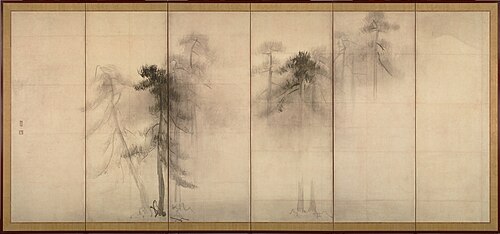Ma (negative space)
 From Wikipedia - Reading time: 7 min
From Wikipedia - Reading time: 7 min

Ma (間, lit. 'gap, space, pause') is a Japanese concept of negative space, and a Japanese reading of the Sino-Japanese character 間.[1][2][3][4]
Ma in Japanese culture
[edit]In modern interpretations of traditional Japanese arts and culture, ma is an artistic interpretation of an empty space, often holding as much importance as the rest of an artwork and focusing the viewer on the intention of negative space in an art piece. The concept of space as a positive entity is opposed to the absence of such a principle in a correlated "Japanese" notion of space.
Though commonly used to refer to literal, visible negative space, ma may also refer to the perception of a space, gap or interval, without necessarily requiring a physical compositional element. This results in the concept of ma being less reliant on the existence of a gap, and more closely related to the perception of a gap.[5] The existence of ma in an artwork has been interpreted as "an emptiness full of possibilities, like a promise yet to be fulfilled", and has been described as "the silence between the notes which make the music".[6]
In arts and crafts
[edit]The tokonoma alcove in a traditional Japanese room is a space or a stage used to display important objects, such as a painting scroll, an important art object, or a flower arrangement. The concept is also associated with oku or the Japanese spatial concept of "inwardness".[7]: 4
In ikebana, the space around the flowers is considered to be equally as important as the flowers and plants themselves, with harmony and balance between the two considered the ideal.[8][9]
In karate, ma refers to the distance between two fighters. Knowing the safe distance between oneself and an opponent based on their reach is considered "understanding ma".
Etymology
[edit]Among English loanwords of Japanese origin, both ma (interval, space) and ken (unit of architectural measurement) are written with the Chinese character 間 derived from the character 門 ("door") and 日 ("sun").
Originally, the character 間 was written with the radical for "moon" (月) instead of the character for "sun" (日), and, in this form (閒, xián), depicted, according to Bernhard Karlgren, "A door through the crevice of which the moonshine peeps in".[10]
The character can be read differently when emphasis is put on the connection between things (awai), the distance between things (aida), or the distance between people (aidagara).[11]
Ma in the West
[edit]In his 2001 book, The Art of Looking Sideways, graphic designer Alan Fletcher discussed the importance that perceived negative space could hold in art:
Space is substance. Cézanne painted and modelled space. Giacometti sculpted by "taking the fat off space". Mallarmé conceived poems with absences as well as words. Ralph Richardson asserted that acting lay in pauses... Isaac Stern described music as "that little bit between each note - silences which give the form"... The Japanese have a word (ma) for this interval which gives shape to the whole. In the West we have neither word nor term. A serious omission.
— The Art of Looking Sideways, page 370[12]
Derrick de Kerckhove described ma as "the complex network of relationships between people and objects".[13]
See also
[edit]- Maai
- Mu
- Wu wei, a term in Chinese philosophy
- Negative space
- Yin and yang
- Liminality
- The Void (philosophy)
References
[edit]- ^ "An Introduction to Japanese". ThoughtCo.
- ^ "FAQ: 'Ma' and 'Mu'". Houzz.
- ^ "ArtLex's Ne-Nz page". Archived from the original on 2012-05-12. Retrieved 2007-12-27.
- ^ "A Note for MA: Space/Time in the Garden of Ryoan-Ji - Iimura". www.mfj-online.org.
- ^ "Ma". www.columbia.edu.
- ^ "When Less is More: Japanese "MA" concept, minimalism & beyond". wawaza.com.
- ^ Kosinski, Jerzy (1995). Passing by: Selected Essays, 1962–1991. Grove Press. ISBN 978-0-8021-3423-3.
- ^ "Ma « Unique Japan".
- ^ Matsumoto, Kiyoshi (24 April 2020). "MA — The Japanese Concept of Space and Time | by Kiyoshi Matsumoto | Medium". Medium.
- ^ Bernhard Karlgren, Analytic Dictionary of Chinese and Sino-Japanese, (Librairie orientaliste Paul Geuthner, 1923) Dover Publications reprint 1974, p. 130.
- ^ Ma et Aïda: Des possibilités de la pensée et de la culture japonaises (in French). France: Éditions Picquier. 2021. p. 56. ISBN 978-2-8097-1521-7.
- ^ The Art of Looking Sideways. by Alan Fletcher. Page 370. Published by Phaidon, 2001. ISBN 0-7148-3449-1.
- ^ Genosko, Gary (2 April 2019). Marshall McLuhan: Theoretical elaborations. Taylor & Francis. ISBN 9780415321716 – via Google Books.
 KSF
KSF